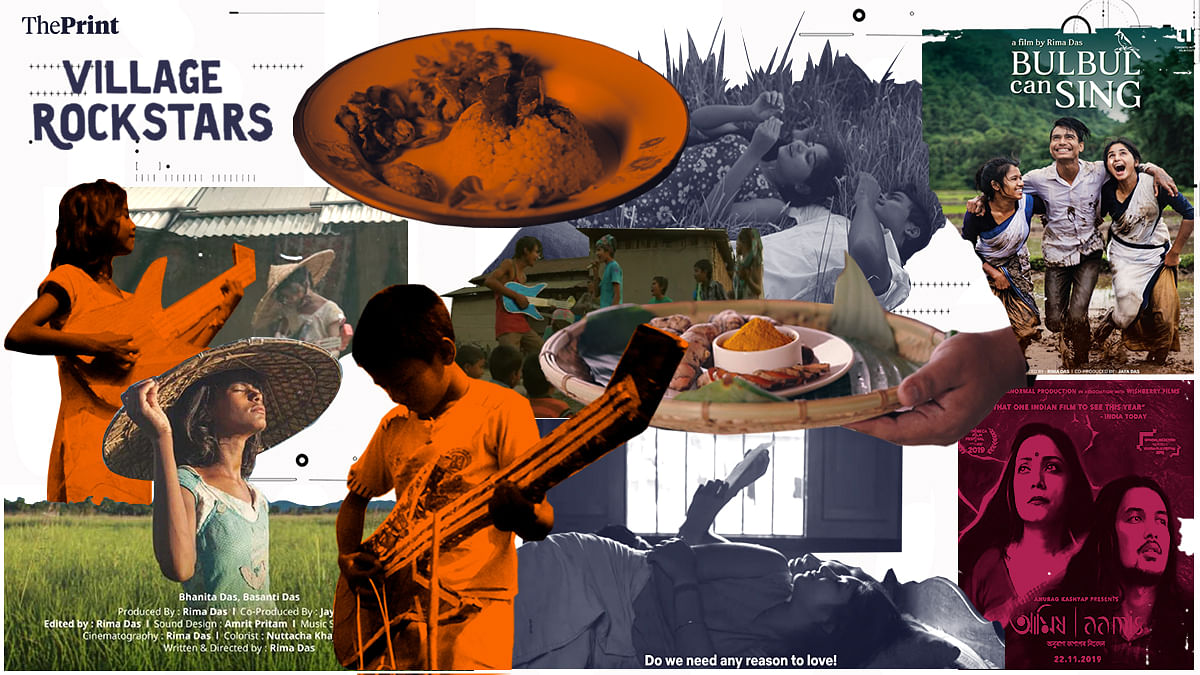“Twenty-five years ago, you would never see a Northeastern face in an ad or film. But in the last few years, actors from the region are getting a chance [in the mainstream],” said Kenny Basumatary, who played one of the army commandos in Jawan.
Today, there are more faces on screen and names in the end-credits of web shows and films from the region. However, acceptance and acknowledgement are still snail-paced. This is especially stark when compared to southern states whose movies have stormed the bastions of Hindi-speaking north India.
Twenty-five years ago, you would never see a Northeastern face in an ad or film. But in the last few years, actors from the region are getting a chance
— actor Kenny Basumatary
Assam, Arunachal Pradesh, Sikkim, Manipur, Mizoram, and Nagaland are brimming with stories. But budgets are small, awareness among the larger audience is low, and most of the well-known movies are coming mainly out of Assam. Moreover, producers, directors and scriptwriters elsewhere in India continue to fetishise the region. Northeast filmmakers are pushing against this culture.
A few years ago, there was a period of visibility on streaming platforms. Films like Village Rockstars (2017), Bulbul Can Sing (2018), Axone (2019), Kothanodi (2017) and Aamis (2021) were being acquired by platforms like Netflix and Sony LIV.
“There was a general feeling that there will be an upsurge of stories from the Northeast from 2022. Digital platforms wanted to buy a lot of shows and films during Covid. But when theatres got back on their feet slowly, this buying spree stopped,” said Shyam Bora, producer and co-founder of Assam-based Metanormal Films.
The big names
For the most part, filmmakers have to rely on buzz to get noticed. Often, indie or low-budget films are bought by OTT platforms based on the waves they make in well-known film festivals or if they are written about in prominent dailies.
That’s how Assamese filmmakers Rima Das and Bhaskar Hazarika were ‘discovered’ by the rest of India. Hazarika’s film Kothanodi (2015)—based on traditional folklore from his home state—was screened at the 20th Busan International Film Festival and won Best Feature Film in Assamese at the 63rd National Film Awards. His second film, a romantic horror Aamis (2019), premiered at the Tribeca Film Festival and received rave reviews in India as well. A PhD student researching meat-eating practices in the Northeast introduces a local doctor–a married woman-to non-traditional meat such as rabbits and bats. Both movies are now available on Sony LIV.
There was a general feeling that there will be an upsurge of stories from the Northeast from 2022. Digital platforms wanted to buy a lot of shows and films during Covid. But when theatres got back on their feet slowly, this buying spree stopped
— producer Shyam Bora
Rima Das stormed into the limelight with her film Village Rockstars (2017), which was selected as India’s official entry to the 91st Academy Awards. The coming-of-age movie is rooted in her experiences growing up in her village, Chhaygaon. The protagonist, 10-year-old Dhunu, dreams of playing the guitar while negotiating life and school in the flood-ravaged village. It was acquired by Netflix, as was her next film, Bulbul Can Sing (2018). This movie, too, draws deep from life in rural Assam, but it is darker. Teenage Bulbul and her best friends Bonny and Suman clash with tradition and patriarchy as they discover who they are and who they want to be.
But barring a few ‘hits’ like Bulbul Can Sing, people have to hunt for movies from the Northeast on obscure platforms. One such platform, Movie Saints, is streaming Anupam Kaushik Borah’s Bornodi Bhotiai (Love, By The River) and Khanjan Kishore Nath’s short film, The Boy with a Gun.
And dubbed versions are preferred over subtitles.
“We may have all cheered Parasite’s director Bong Joon-ho’s quote about one-inch subtitles that can open up your world. But when I use that quote in front of an OTT executive, he will say that it makes much more sense to dub it in Hindi,” said Bora of Metanormal Films.
Even within the Northeast, there’s a pecking order. The language predominantly found on OTT platforms is Assamese. Movies from Mizoram, Manipur, Sikkim, Nagaland, and Arunachal Pradesh are glaringly absent.
We may have all cheered Parasite’s director Bong Joon-ho’s quote about one-inch subtitles that can open up your world. But when I use that quote in front of an OTT executive, he will say that it makes much more sense to dub it in Hindi
— producer Shyam Bora
Both Basumatary and Bora attribute it to the fact that, at the end of the day, digital platforms are market-driven spaces. With no awareness, marketing, or promotions, people don’t know what to look for. It doesn’t help that the head honchos are almost always from central and north India.
“The decision-makers want content to be similar to what they know and not really risk anything new,” said Bora.
Another factor is that within the region, there is no homogeneity of language. One state can have different communities speaking separate languages. This further divides the subscriber base. It ultimately comes down to numbers over representation or diversity.
Food, racism, politics
In Aamis, the PhD student Sumon declares that the definition of normal isn’t universal. He is talking about meat, but this can be extended to how the rest of India views people from the Northeast. Filmmakers in the region are battling mainstream culture’s need to fetishise their lives.
Popular shows associated with the Northeast region have been primarily about food–peppered with words like ‘unusual’ and ‘exotic’. But at the same time, they are proving to be a good entry point into the region.
It started with Masterchef India Season 7, when one of the mystery box challenges included roselle leaves. This plant is used by several communities and known by different names. The two finalists in the show, Nayanjyoti Saikia and Santa Sarmah, were both from Assam. Saikia eventually won the season, with his dish of the traditional ‘haah joha kumura’ or duck curry with ash gourd. Sarmah created a plate with chicken cooked inside a hollowed bamboo and fermented rice.
Meghalaya’ s first TV series on a pan-Indian platform, Jio Cinema, was a reality show. In Hills on a Plate-Meghalaya, seven contestants from the state competed for the cash prize of Rs 2 lakh. The opening credits of the show featured stunning shots of the many attractions of the state, from waterfalls to valleys. The cooking show combined not just the quintessential curiosity of northeastern food but also the ever-growing tourism industry in Meghalaya, with regular ‘offbeat’ treks to its many stunning waterfalls.
Popular shows associated with the Northeast region have been primarily about food–peppered with words like ‘unusual’ and ‘exotic’. But at the same time, they are proving to be a good entry point into the region.
What the show highlighted is that while the states are often lumped together under an umbrella term, the reality is that every state has its own unique culture. From the contestants to the judges and ingredients, the show focussed on traditional cooking techniques, like steaming, broiling, and fire roasting, and the use of local ingredients like the Lakadong Turmeric, which Meghalaya has a GI tag for.
Hosted by Gordon Thabah, RJ at Radio Mirchi Meghalaya and Abigail Pamei, an entrepreneur and TV personality who runs Kaizun Bed and Breakfast, and owns Kaizun Bridal Couture, the show did not rely on just judges from Hindi-speaking states.
“This journey has been extraordinary as it has given me a chance to explore the rich, diverse, and unique flavours of Meghalaya. From traditional techniques to innovative dishes, the culinary landscape here is truly inspiring,” MasterChef Australia’s Sarah Todd wrote in an Instagram post. She was one of the judges along with Ardahun Passah, one of the brains behind the popular Himalayan restaurant, Yeti, which has branches in Delhi, Pune, and Dehradun, and William Diengdoh, a local chef.
Even in fiction formats, food remains a preoccupation.
One of the first films from Northeast that was released exclusively on an OTT platform was Nicholas Kharkongor’s Hindi film Axone (2019). The movie follows a day in the life of a group of friends from the Northeast and their time in South Delhi’s Humanyunpur. The key ingredients to the comedy are a wedding, axone (a popular ingredient in Naga cuisine), and a clash between landlord and tenant.
In the last five years, stories about the Northeast, and actors from the region, have found some presence on screen, with movies like Anek (2022) by Anubhav Sinha, and Bhediya (2023), directed by Amar Kaushik, and most recently, Jawan.
Director Kharkongor uses comedy to depict the everyday racism that people from the Northeast experience. At the same time, Axone shines a light on Humanyunpur and the overwhelmingly Northeastern tenants in Jat-owned houses. The neighbourhood has boutiques and restaurants that offer food from various tribes and communities.
In Aamis, too, ‘forbidden’ desire is expressed through eating foods that are considered ‘exotic’. The culinary journey becomes a metaphor for lovemaking between the student and the doctor, neither of whom is willing to transgress society’s rules laid down for marriage and love.
The disruptors and big screen legacy
In mainstream Bollywood movies, traditional heroes are mainly city-born, north Indian upper middle-class who may not be able to correctly locate the seven Northeastern states on the map. Now, a handful of actors like Chum Darang from Arunachal Pradesh, Bodhisattva Sharma from Assam, and Mairembam Ronaldo Singh from Manipur are pushing back.
In Badhaai Do, a school PT teacher Sumi (Bhumi Pednekar) develops a crush on a pathologist, Rimjhim Jongkey (Chum Darang), with whom she eventually gets into a relationship. It is crucial because it’s one of the rare instances where an actor from the region is cast as a romantic partner to the hero, with almost 40 minutes of screentime in the 147-minute film.
Both Bodhisattva Sharma and Mairembam Singh played important characters in the first season of Paatal Lok (2020). While Sharma plays Siddharth, the son of one of the main characters essayed by actor Jaideep Ahlawat, transgender actor Singh plays a transgender named Cheeni or Mary Lyngdoh. The casting team travelled to Manipur to find trans-actor instead of picking a cis-het individual for the role.
With directors Raj Nidimoru and Krishna DK, popularly known as Raj & DK, also preparing to travel all the way to the region, there might yet be hope. Even Manoj Bajpayee wants to be in the Northeast for Season 3 of his hit show, The Family Man.
Still, few Northeast actors today are easily recognisable or regarded as ‘bankable’—unlike, say, Danny Denzongpa from Sikkim, the popular villain of the 1980s, or Adil Hussain from Assam, known for his offbeat roles.
In the past, Bollywood has made many missteps in representing the Northeast. When Shah Rukh Khan and Malaika Arora danced to Chaiyya Chaiyya song in Mani Rathnam’s Dil Se (1998) on top of a train, with men in background in japis, people were mesmerised. But the backdrop of the movie, which looked at the insurgency in the Northeast, was missed by most audience members. In the movie, Khan is an All India Radio reporter Amar who talks about Assam’s gun-toting insurgents, as well as their sympathisers. But it was highly misrepresentative of the ground reality.
In the last five years, stories about the Northeast, and actors from the region, have found some presence on screen, with movies like Anek (2022) by Anubhav Sinha, and Bhediya (2023), directed by Amar Kaushik, and most recently, Jawan. Anek’s intent was to show the Northeast as one. But it misses the beat, and ends up stereotyping the region. The film was acquired by Netflix while Bhediya was taken up by Jio Cinema after their respective theatrical runs.
While making the horror comedy Bhediya, Amar Kaushik relied on his own experience of growing up in Arunachal Pradesh. He steers clear from exoticising the Northeast, while drawing from folklore and tribal culture. Kaushik also got Arunachali cinematographer Nyago Ete, actor Paalin Kabak, and rapper K 4Kekho to be part of his film.
Bhediya is set in Ziro, which has held an annual music festival since 2012, promoting indigenous tribes and artists from Northeast India and showcasing Indian and global independent music. The Ziro Music Festival, held on the last weekend of September every year, relies on sustainability, and is organised with the cooperation of the Apatani tribe from the valley.
Looking toward the NE
The region too has a role to play in its own representation. “The only thing that comes to my mind is, probably what we lack, in NE, a producer who understands marketing. They do not even think about taking it to a national platform; they do not envision,” said actor Adil Hussain, known for his roles in movies like English Vinglish (2012), Life of Pi (2012), and Kothanodi (2017). He added that the quality of films, not just artistically but also commercially, is not at par with films from other regions.
With directors Raj Nidimoru and Krishna DK, popularly known as Raj & DK, also preparing to travel all the way to the region, there might yet be hope.
Even Manoj Bajpayee wants to be in the Northeast for Season 3 of his hit show, The Family Man.
“We will start shooting at the end of February and this time we will mostly shoot in the North-East,” he said in an interview earlier this year. The second season of Paatal Lok is being shot in Nagaland, and has Merenla Imsong as part of its cast. Basumatary, who is a prominent filmmaker in Assam known for Assamese martial art comedies like Local Kung Fu (2012), Local Kung Fu 2 (2017) and Local Utpat (2022), has a small role in the show.
“We have the stories, but they have to be written in a professional format in a pitch deck, so that they can be sent to big OTT platforms,” said Basumatary.









